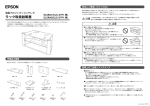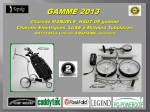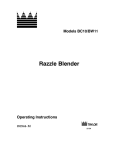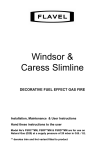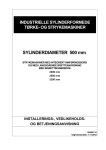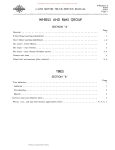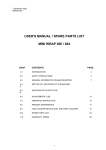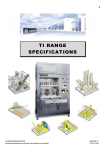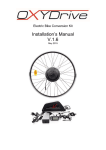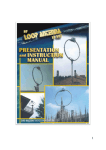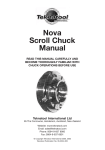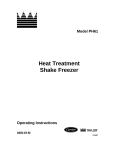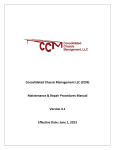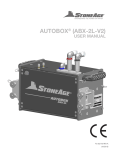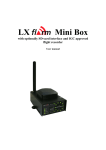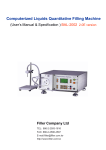Download Manuel d`utilisation
Transcript
NSD Grain Cleaner User's manual, Installation And commissioning Edit. 05.03.13 Avenue Louis DENIS - 28160 BROU France –Téléphone 33. (0)2.37.97.66.11 – Télécopie 33. (0)2.37.97.66.40 – www.denis.fr Grain cleaning is achieved by removing: - light waste with aspiration, - small waste by screening, - oversized waste by scalping. 2 Utilisation du NSD DGHD1 05.03.13 Index I. PRESENTATION ................................................................................................ 4 A. Cleaner Separator NSD ...................................................................................... 4 B. Operation ............................................................................................................ 6 C. Main points ......................................................................................................... 7 1. 2. 3. 4. II. Initial aspiration ....................................................................................................................... 7 La grille supérieure (émottage)................................................................................................ 7 Lower screen (screening) ........................................................................................................ 7 Final aspiration........................................................................................................................ 7 USES................................................................................................................... 8 A. Aspiration ............................................................................................................ 8 1. 2. 3. 4. 5. 6. Grain curtain ........................................................................................................................... 8 Initial and final aspirations ....................................................................................................... 8 Central aspiration .................................................................................................................... 8 Throughput ............................................................................................................................. 9 Aspiration rejects outlets ......................................................................................................... 9 Fan outlet ................................................................................................................................ 9 B. Screens ............................................................................................................. 10 1. 2. 3. III. Removing screens ................................................................................................................ 10 Fiiting screens ....................................................................................................................... 10 Notes .................................................................................................................................... 10 SCREENS SELECTION ................................................................................... 11 A. Principles .......................................................................................................... 11 B. Montages courants ........................................................................................... 11 C. Mixed settings ................................................................................................... 12 1. 2. 3. 4. Principle ................................................................................................................................ 12 Accuracy and capacity .......................................................................................................... 12 Montage simple ou composé................................................................................................. 13 Screen selection ................................................................................................................... 13 D. Modified flowcharts ........................................................................................... 14 1. 2. All scalping............................................................................................................................ 15 All screening ......................................................................................................................... 15 IV. CONTRÔLES ET CORRECTIONS .................................................................. 16 A. Aspiration .......................................................................................................... 16 B. Screens ............................................................................................................. 16 V. INSTALLATION ................................................................................................ 18 A. Assembly and Setting up .................................................................................. 18 1. 2. Access .................................................................................................................................. 18 Feeding ................................................................................................................................. 18 B. Inlet and outlets connections ............................................................................ 19 1. 2. 3. 4. Inlet ....................................................................................................................................... 19 Outlets .................................................................................................................................. 19 Aspiration rejects .................................................................................................................. 20 Fan ....................................................................................................................................... 20 C. Screens and screen boxes ............................................................................... 21 1. 2. 3. 4. 5. 6. 7. Balls ...................................................................................................................................... 21 Mounting element of screen .................................................................................................. 21 Handling mounted element of screen .................................................................................... 21 Release system .................................................................................................................... 21 Screen boxes balancing ........................................................................................................ 21 Others controls...................................................................................................................... 21 Mounting scalping/screening kit ............................................................................................ 22 D. Electrical wiring ................................................................................................. 23 E. Direction of rotation .......................................................................................... 23 VI. COMMISSIONING ............................................................................................ 24 A. Screen setting ................................................................................................... 24 B. Feeding rate...................................................................................................... 24 1. 2. Center the grain flow with chute diverters .............................................................................. 24 Make regular grain curtain using counter weights .................................................................. 24 C. Aspiration adjustments ..................................................................................... 24 D. Protection covers .............................................................................................. 24 VII. A. B. C. D. MAINTENANCE ................................................................................................ 25 Checking ........................................................................................................... 25 Tightening ......................................................................................................... 25 Screens condition ............................................................................................. 25 Screens boxes, aspiration and outlets ............................................................. 25 VIII. SPARES PARTS .............................................................................................. 26 Utilisation du NSD DGHD1 05.03.13 3 I. Presentation A. Cleaner Separator NSD Cleaner Separator with two screen boxes 4 Utilisation du NSD DGHD1 05.03.13 A. Feeding and initial aspiration 1. Grain inlet 2. Built in chute box - Spreader 3. Air lifting chimney 4. Feeding hopper 5. Feed roll 6. Counterweighted distribution flap 7. Grain curtain 8. Divider 9. Lower screen box feed 10. Upper screen box feed B. Screen boxes 11. Upper screen (scalping) 12. Large impurities (scalping) 13. Lower screen (screening) 14. Good grain outlet 15. Small impurities outlet (screening) 16. Screen fitting door 17. Screen fixing wedge C. Final aspiration 18. Clean grain outlet and sampling point 19. Double cascade aspiration 20. Final air lifting chimney 21. Good grain channel D. Expansion chamber 22. Final aspiration rejects outlet 23. Initial aspiration rejects outlet 24. Central aspiration 25. Expansion chamber 26. Final aspiration adjustment 27. Initial aspiration adjustment 28. Air with light dust outlet 29. Fan Utilisation du NSD DGHD1 05.03.13 5 B. Operation NSD 1 Principles of use are adaptable to other cleaner separator But NSD differs in some important features : - final aspiration on a double cascade outlet, - two balanced screen boxes, - exchangeable split screen elements, - possible 'all scalping' or 'all screening' operation. NSD 2 The raw product goes into the intake hopper. A counterweighted distribution flap spreads the grain flow across the width of the machine [1].. A regular grain curtain is important to provide: - efficiency of initial aspiration, - equal distribution between the two screen boxes for NSD2, - even spreading across screen width, thus efficiency of separation, - accuracy of final aspiration. Initial aspiration draws air through the grain curtain and removes dust and light particles. Aspirated materials carried into expansion chamber settle out and are extracted by the auger. For NSD2, a divider divides the grain flow of grain between the two screen boxes, and in a screen box : An upper screen (scalping) retains large rejects which leave the machine through a side outlet, [2] and allows good grain to pass through and fall on the lower screen. A lower screen (screening) allows small impurities to leave the machine through a side outlet, [3] and retains good grain which passes to the final aspiration. Final aspiration draws air through a double grain cascade and removes light particles and small light grains. [4] Rejects from the final aspiration settle in the expansion chamber and are extracted by the auger. Dusty air from the fan is evacuated to a cyclone or a filter. 6 Utilisation du NSD DGHD1 05.03.13 C. Main points Rule of thumb: Adjustments and throughput depend on kind and amount of impurities. To remove larger impurities, use smaller perforations for scalping and reduce throughput. To remove smaller impurities, use larger perforations for screening and reduce throughput. To remove lighter rejects, better use the final aspiration and reduce throughput. 1. Initial aspiration Removes dust and very light impurities. On heterogeneous raw sample at entry, only a light aspiration is effective to help further separation with screens. Initial aspiration is really a precleaning aspiration. 2. Upper screen (scalping) Retains large impurities with perforations small enough ensure the accuracy but large enough to loose no good grain whilst maintaining adequate throughput. Round holes can sometimes be used to separate by length. 3. Lower screen (screening) Allows small impurities to pass through the screen with perforations large enough for efficiency but small enough to loose no good grain. With split screens one can use round holes and slots together for better screening on seed cleaning or fine cleaning (e.g. organic grain). 4. Final aspiration Removes light impurities. Final aspiration works on a uniform finished sample where homogeneous grains can be separated by density after the cleaning process. Final aspiration is more accurate with the high air lifting chimney and must remain the main aspiration. Utilisation du NSD DGHD1 05.03.13 7 II. Uses Avoid doing several adjustments at the same time and wait after making an adjustment before checking. Check the rejects while increasing the adjustment, until some good product discharges with the rejects, and then reduce a little. Rubble Separation, Cleaning, Fine Cleaning or Grading may be performed by changing the screens for screening or for scalping. The kind of operation depends on the volume of small or big rejects to be removed, and on the acceptable throughput. Accuracy increases with lower throughput and screens close to the grain size. Throughput increases with larger perforations on scalping screens . A. Aspiration Rule of thumb: Grain must flow evenly across the whole width of the machine as a complete curtain. Depending on type of grain and throughput, adjust air volume after checking reject material. 1. Grain curtain After the counterweighted flap, the grain must flow evenly across the whole width as a curtain. If the grain flows leaving gaps, the air flows through the gaps and the cleaning is inefficient. This is why the cleaner must be fed on its axis and the built-in chute box adjusted if needed.. The counterweight adjustment should permit the formation of the regular curtain across the width. Increasing the effect of the counterweights to keep enough grain and ensure that it regularly over the entire width. The grain begins to appear through the side window. The counterweight feed distribution flap must not rub the sides of the machine and should swing freely in order to react to throughput variations. 2. Initial and final aspirations Depending on the air speed, more or less particles are separated from the grain curtain. Depending on density, a light grain is separated faster than an heavy one. Depending on the shape, a small grain is separated faster than a large one. On an heterogeneous product, with small and large particles, separation by density is inefficient. Initial aspiration is only used for precleaning or dust removal. Final aspiration allows a better density separation on homogeneous grain after the screens. The double grain cascade produces a uniform flow and prevents unwanted air entry. The high chimney improves accuracy and regularity. Final aspiration should always be favored for actual density separation. 3. Central aspiration The lever centrally located between the two handles for adjusting the initial and final aspiration, order the taking of additional air that puts the device in depression. It is used to decrease or increase the power of aspiration: If the settings are limited, a facility where the aspiration is too powerful, the opening of this additional air inlet, taking part in the volume of air, decreases other aspirations and the adjustment range s' finds enlarged. If you need more power to draw more grain, the closure of the air intake allows all power for the final aspiration on the grain. 8 Utilisation du NSD DGHD1 05.03.13 4. Throughput Throughput depends on the handling equipment feeding the machine. When feed rate increases, aspiration must increase too. At high capacity, only very light impurities can pass across the thick grain curtain. Only dust removal is achieved. For a finer job, reduce capacity. 5. Aspiration rejects outlets The flaps on the aspiration outlets are kept closed by depression produced by the fan. The accumulation of light particles produces a kind of sealing. Under pressure from the screw, the rejects out by pushing the flap which closes immediately Ensure the flap does not stick against the sides of the outlets and moves freely. Check these rejects before any adjustment of the aspiration. . 6. Fan outlet The air from the fan is still loaded with light dust. To avoid reducing the air flow, duct to the cyclone should be as short as possible with few elbows and no restrictions (e.g. 15m straight or 10m with an elbow) Utilisation du NSD DGHD1 05.03.13 9 B. Screens Rule of thumb: Upper screen must have perforations large enough to allow good grain through and small enough to retain a maximum of large impurities. Lower screen must have perforations small enough not to allow good grain through and large enough to allow a maximum of small impurities through. 1. Removing screens It is advisable to install a work plan to allow up to raise the screens boxes for dismantling and reassembling them easily Door opening loosens the release system. Pull it completely to release the screens. After removing the fixing wedge, pull out each element of screen and its ball frame. Hold them on each side. Place screen and frame on a level surface to separate them easily. Lift up the end of the screen and pull to disengage the other end out of the frame fold. 2. Fitting screens (See screen selection) Engage the double end of the split screen in the frame fold, [3] and press down the other end in position into the frame. Push each split screen with its frame, inside the screen box and check the junction overlap. Insert the fixing wedge after the screens. It will push and block the screens in the box when the door is closed. Securing the door will also operate the release system and move it down the screens. 3. Notes a) Balls frames When removing screens, check number and position of rubber balls. Each cluster should contain at least 4 balls. b) Elements of screens See: Mixed settings of screens. To avoid increasing the stock of screens and build suites of perforations, each screen level can use two elements of screens with different (but close) perforations We can use larger perforation first for scalping level (e.g. Ø8.0 and Ø7.0) We can use smaller perforation first for screening level (e.g. 2.10x20 and 2.50x20). c) Bouncing grain Wet and dirty grains are steady and bounce less, but when dry hard grains begin to bounce at the end of the screen, a glass fabric suspended across the upper screen, will prevent the escape of bouncing grains. d) Length separation of grain Round holes can be used for a separation according to the length. At a reduced throughput, the fixing wedge at the beginning of the screen, allows the grains to enter and stay flat on the screen. Long grain tends to slide over the perforations and short grain tends to topple over. 10 Utilisation du NSD DGHD1 05.03.13 III.Screens selection A. Principles Screens selection is an important factor affecting capacity, precision and efficiency. It is a compromise between capacity and quality of cleaning: To increase the capacity (precleaning, fast cleaning), increase perforations of upper screen To increase the quality (seed cleaning, fine cleaning), increase perforations of lower screen. With too high a throughput, losses occur without getting the required level of quality: - Upper screen (scalping) will not allow all good grains through and some will escape to the large rejects. - Lower screen (screening) will not allow all small impurities through and some will remain in the good grain. For a given throughput, the best job is achieved with: - Perforations of upper screen small enough to retain a maximum of large impurities, - Perforations of lower screen large enough to allow a maximum of impurities through. Even with the ideal perforation, separation is never perfect. Keep in mind that you cannot achieve zero impurities in the good grain without having good grain in rejects. Slots are often better adapted to the reciprocating movement of the separator, but round holes are generally used on upper screens for round grains. Choose a perforation with a handful of grains on a spare screen and accept using an approximate screen size for a particular sample so as not to increase too much your stock of screens. B. Usual settings of screens The table below can help decide which perforation to use, but granulometry changes with variety, region and year. These perforations are merely indications: Perforations Oats Oat (seed) Wheat Wheat (seed) Grading Barley* Rape seed * Lentils Flax Maize Barley Barley (seed) Peas Peas (seed) Rice Buckwheat Rye Soya bean Sorghum Sunflower Upper screen 4,50 x 20 4,00 x 20 4,50 x 20 4,00 x 20 4,50 x 20 Ø 3,50 Ø 5,50 2,50 x 20 10 x 30 4,50 x 20 4,00 x 20 Ø11 Ø10 Ø10 Ø 5,0 3,50 x 20 Ø 9,00 Ø 6,00 Ø12 Lower screen 1,75 x 20 2,10 x 20 2,10 x 20 2,65 x 20 2.50 x 20 Ø 1,60 Ø 3,50 1,75 x 20 Ø 6,00 2,10 x 20 2,40 x 20 5,00 x 30 6,00 x 30 Ø 3,00 2,40 x 20 1,75 x 20 4,50 x 20 Ø 3,00 Ø 4,00 * See modified flowcharts Each level of screen consists of 2 elements. For NSD1, with one screen box, it takes 4 screens elements to set 2 levels of screens. For NSD2 with 2 screens boxes each item must be doubled to enable the same assembly in both screens boxes. Mixed settings are possible using different elements in each screen level. Utilisation du NSD DGHD1 05.03.13 11 C. Mixed settings of screens With simple settings, each perforation is doubled to fit on each of both screen boxes. But with interchangeable element of screen on NSD, mixed settings are possible using two different elements at each screen level. This increases the adjustments possible according to grain size, required throughput or type of cleaning. 1. Principle On upper screen, most grains pass through the first half screen. The second element of screen may have smaller perforations to allow the last remaining grains through and retain larger impurities, improving accuracy of scalping with nearly no reduction of capacity. Another way is to have the second half screen with 'standard' perforation and fit a larger perforation on the first half screen and thus increase the throughput On lower screen, all grains pass on the second half screen. The first element of screen may have smaller perforations to allow screening of the first grains. For cereals, it was generally advantageous to use long holes on the first element to remove small grains and broken grains, and round holes on the second element to eliminate small round grains (cleavers, wild mustard, wild radish). 2. Accuracy and capacity Mixed screen sizes allow more flexibility: to increase capacity with larger scalping perforations or otherwise increase accuracy with a tighter scalping. to increase screening separation with larger screening perforations or by using round holes and slots together. The following table shows examples of these two settings for each product: Mixed settings Wheat Wheat Oat Oat Rapeseed Rapeseed Broad beans Broad beans Lentils Lentils Maize Maize Barley Barley Peas Peas Rye Rye Soya bean Soya bean Sunflower Sunflower 12 standard variant standard variant standard variant standard variant standard variant standard variant standard variant standard variant standard variant standard variant standard variant ½ upper screens 4,50x20 4,00x20 5,00x30 4,50x20 4,00x20 3,75x20 4,50x20 4,00x20 Ø3,5 Ø3,0 Ø4,0 Ø3,5 Ø14 Ø12 Ø16 Ø14 Ø6,0 Ø5,5 Ø6,5 Ø6,0 Ø14 Ø12 Ø12 10,0x30 4,50x20 4,00x20 4,00x20 3,75x20 Ø11 Ø10 Ø12 Ø11 4,00x20 3,75x20 4,50x20 4,00x20 Ø10 Ø9,0 Ø11 Ø10 Ø12 Ø11 Ø14 Ø12 Utilisation du NSD DGHD1 05.03.13 ½ lower screens 2,10x20 Ø3,0 2,20x20 Ø3.5 1,75X20 Ø3,0 2,00X20 Ø3,5 plain Ø1,6 Ø1,6 Ø1,8 Ø5,5 4,50x30 Ø6,0 5,00x30 Ø4,0 1,75X20 Ø4,5 1,75X20 Ø4,0 Ø5,5 Ø6,0 4,00x20 2,10x20 Ø3,0 2,20x20 Ø3,5 Ø5,5 4,50x20 Ø6,0 5,00x30 1,75x20 Ø3,0 2,10x20 Ø3,5 Ø3,5 4,00x20 Ø4,0 4,50x20 Ø4,0 2,10x20 Ø4,0 2,20x20 3. Simple or mixed screens setting We can compare the simple and mixed settings with an example of screen for cleaning 5 grains current: With a 'simple' setting, each element must be doubled. We should be used 14 elements to have 7 perforations (1.6 - 3.5 - 4.0 - 10 - 11 - 2.10x20 - 4.50x20), which allows the followings operations: Simple setting Wheat Barley Sunflower Rapeseed Peas upper screens 4,50X20 4,50X20 4,50x20 4,50X20 Ø11 Ø11 Ø3,5 Ø3,5 Ø10 Ø10 lower screens 2,10x20 2,10x20 2,10x20 2,10x20 Ø4,0 Ø4,0 Ø1,6 Ø1,6 4,50x20 4,50x20 With a mixed setting, avoiding duplication, can be an equivalent job with 10 screens with 10 different perforations (1.6 - 3.5 - 4.0 - 10 - 11 - 12 - 2.10x20 - 4.00x20 - 4.50x20 - full) Mixed setting Wheat Barley Sunflower Rapeseed Peas upper screens 4,50X20 4,00x20 4,50x20 4,00x20 Ø12 Ø11 Ø3,5 Ø3,0 Ø11 Ø10 lower screens 2,10x20 Ø3,0 2,10x20 Ø3,0 Ø4,0 2,10x20 plain Ø1,6 Ø4,0 4,50x30 The more the number of grains increased this type of setting required mixed settings. As an average, number of screens decreases by one third, while number of perforations increases by one third. 4. Screen selection Rather than a perforation corresponding precisely to one use, better to have a versatile element. Try to optimize your list of screens and avoid having the same perforation twice except for specific jobs like grading malting barley (2.50x20) and aim for a range of perforations. That will lessen the total number of screens and increase the number of different perforations. So you will probably have the next perforation allowing adaptation for capacity or increasing accuracy. Note : For NSD2, the following text upper screens 4,50x20 4,00x20 Wheat lower screens 2,10x20 Ø3,0 means we have the same screens in the two boxes of the cleaner, with the screens elements installed physically like : (Inlet gross grain) Upper screen Box Upper screen 4,50x20 4,00x20 Lower screen 2,10x20 Ø3,0 Lower screen box Upper screen 4,50x20 4,00x20 Lower screen 2,10x20 Ø3,0 (Outlet clean grain) Utilisation du NSD DGHD1 05.03.13 13 D. Modified flowcharts Standard flowchart (standard cleaning), uses two levels of screens in both screen boxes of the cleaner separator, to remove: large impurities with upper screen (scalping) small impurities with lower screen (screening). But some jobs require only one of these functions at a reduced capacity: Scalping when cleaning rapeseed: Upper screen only is required to remove pods, staw, weed seeds, cleavers and large impurities. Small impurities are easily removed with aspiration. A lower screen, which removes little, is often replaced by a plain screen. Rapeseed cleaning is achieved only by scalping at a throughput ±30% of that of wheat. Screening when grading malting barley: Lower screen only is required to remove small grains. An upper screen removes nothing from clean barley. Grading barley is achieved only by screening at a throughput ±10 to 20% of that of wheat. Only scalping Only screening Modularity of NSD allows using all screens for scalping, or all screens for screening, doubling the throughput for such operations. Depending on the grain and type of cleaning and required throughput, the diagram is modified to use all screens for screening or all screens for scalping: The blocking wedge of upper screen is replaced with a divider wedge which splits the grain flow between upper and lower screen. A double bottom is fitted to isolate lower from upper screen. End outlets for screens and bottoms are fitted with: - flat direct outlet sending good grain to final aspiration - side channel outlet sending rejects outside the screen boxes. 14 Utilisation du NSD DGHD1 05.03.13 When grading malting barley, all screens can be used for screening.(option) When cleaning rapeseed, all screens can be used for scalping. (option) 1. All scalping When cleaning rapeseed, the lower screen is not very useful and often replaced with a plain sheet. Aspiration removes all small rejects. All screens can be used for scalping with perforations Ø4.00 and Ø3.50. Good grains pass through and fall on the bottom equipped with a flat outlet. Rejects retained on top of the screen get out through a side outlet. 2. All screening When grading malting barley, 'seconds' are removed through screens 2.50x20. With clean barley, the upper scalping screen is unnecessary. All screens can be 2.50x20 for screening 'seconds'. Good grains (graded barley) retained on top of the screen equipped with a flat outlet. Seconds get out through a side outlet . These modified flowcharts are not used only for grading barley and cleaning rapeseed. They will be used with other products when possible if there is no need for scalping or no need for screening. Utilisation du NSD DGHD1 05.03.13 15 IV. Controls and adjustments A low throughput is always better for difficult jobs. Capacity can be increased later. There is never a perfect adjustment: Always try to reduce the impurity rate in the final sample by increasing setting to the limit where some few good grains go out with rejects. Keep in mind that with about 1% of rejects, up to 10% of grain in reject is affordable: The total loss is less than 0.1%. In case of trouble, try the followings corrections: A. Aspiration Rejects in good grain: - Irregular 'curtain' of grain: Poorly adjusted counterweight, move the spreader in the chute box. - Too strong aspiration: Check cyclone, fan or filter outlet or pipes. - Uneven aspiration: Check feeding or aspiration outlet flap left close. Good grain in rejects: - Irregular 'curtain' of grain: Poorly adjusted counterweight, feeding from the side. - Too low or uneven aspiration: Check aspiration outlet flap left close. Vibrations, noises - Fan: dirty blades, bearings - Feed roll rubbing - Trash auger stopped or running the wrong way No outlet from trash auger, grains in the cyclone or filter: - Trash auger flap rubbing or blocked - Arch of product in expansion box - Trash auger stopped B. Screens Good grain in small rejects: - Too big perforation for screening, - Screen not fitted correctly or damaged, Good grain in big rejects: - Throughput too high, - Too small perforations for scalping, - Blind screen: Clean and check rubber balls, Rejects in good grain: - Broken, Small trash: Screening perforations too small, too high throughput, - Big rejects, Straw: Rubble perforation too big, too low feeding Vibrations, noise: - Door not locked. - Screen not fitted properly or damaged, - Screen boxes unbalanced. 16 Utilisation du NSD DGHD1 05.03.13 Utilisation du NSD DGHD1 05.03.13 17 V. INSTALLATION A. Assembly and Setting up When positioning, make sure you have enough space around machine for easy use, adjustments, screen fitting and maintenance. See drawing of the machine for "Dimensions and Clearance". See drawing "Cleaner Separator on stand". See User's manual (page 4) for identification of each element of cleaner. NSD comes usually with: - Accessories (hoppers, connection parts), - Boxes of rubber balls (under lower screen box), - Screens (by elements of 800x1000). Use the lifting points to handle the machine and put it in position. The support, or stand, must be rigid enough to prevent any structure deformation while running, and be perfectly horizontal to keep a high level of efficiency (even grain repartition on screens). For NSD1, which vibrates more, feet of the frame must be square to the feet of the cleaner to transmit directly to ground efforts. Lifting points 1. Access Allow sufficient clearance around the machine either on ground level, on platform or stand. Keep clear three areas: Screen fitting: 1.30m length (minimum 1.10m) across the width of the machine with room on the side or at the rear for screen storage. Control at outlets and adjustments: 0.80m width (minimum 0.40m) Access for maintenance on opposite side. Screen fitting area must be level with cleaner (or even 15cm upper) for easy access to screens. A box for screen storage will allow room on top to put element of screen and frame when mounting or dismounting. 2. Feeding Mount the feeding cone on cleaner entry with chute diverters pushed aside at maximum. Each diverter is fixed with screws in slots on top of the cone to allow positioning for re-centering grain flow when necessary. Remove them when unnecessary. Feeding cone and chute Fit counterweighted flap when counterweights are well fixed. diverters Adjustable edges keep enough sealing and prevent side impinging. Fitting and removing counterweighted flap is easily done by tilting then lifting flap to disengage from pleat. Counterweighted flap Dismounting counterweighted flap Fan is connected on top of cleaner with a free rotating flange allowing any direction for exhaust piping. 18 Nettoyeur Séparateur NSD - Manuel d'installation, mise en service et entretien B. Inlet and outlets connections Connections dimensions are designed for specific flanges or accessories. Check each connected element according to throughput and dimensions of device. See drawing for connection flange. 1. Inlet Feed on the axis and leave 0.3 to 1 m of vertical pipe to help center grain flow (Fig.1). If you cannot avoid direct feeding from the side (Fig. 2), or if chute speed is too fast, add a chute box. Take care not to put it with same orientation than grain flow (Fig. 3). A chute box is generally better installed when oriented in the axis of a machine (Fig. 4). Feeding a machine The rate of feed is an important point when adjusting a cleaner. It cannot be done at inlet to avoid overflow on preceding handling equipment. Feeding rate is always adjusted at first point of circuit by a graded gate to allow enough accuracy. 2. Outlets a) Good grain Cleaned grain flows across the width of the machine at the bottom of final air lifting chimney. The good grain hopper can have an opening, with cover, allowing even sampling across all grain flow. Good grain hopper and screen rejects hopper with sampling doors. b) Screen Rejects The screen rejects hopper, with sampling door, allows connection through a standard flange to the reject circuit or to a bagging device. Main cover for outlets should be fitted to be easily removed and allow exchange of outlets and check on rejects flow. Installation et entretien du NSD DGHD2 05.03.13 19 3. Aspiration rejects Aspiration outlet flaps open with pressure of rejects pushed by the screw and close with depression of aspiration and allow no air entry which could hinder aspiration adjustments. Aspiration rejects outlet Flap setting Outlet flap can be set up on its hinge to prevent impinging on the sides of the outlet and allow free opening and closing, even if outlet is a little warped by a bad connection of a pipe. Make sure rejects can flow freely: When rejects pile in pipes, screws can be quickly blocked and break a driving belt (Rep. 12 spare parts drawings). 4. Fan The fan is connected on top of the cleaner with a crazy bride who can steer in any direction. In order to avoid loss of strength and efficiency of aspiration, exhaust piping should be as short and direct as possible, using - reduced number of elbows, - pipes with a cross section equal or bigger than fan exhaust, - and avoiding sharp variations in shape and cross section of pipes. Outside direct exhaust of dust is generally unacceptable. A reverse filter should be the only way to have absolutely no dust rejected outside, but is an excessive cost for a small installation. Sometimes, a dust expansion chamber (30 to 50 m³) with appropriate passages could leave sufficiently clean air out and retain most of dust. But generally, a cyclone is the best choice, even with its reduced efficiency (maximum ±95%). Balancing the cyclone can be improved by adjusting the air outlet (butterfly valve or adjustable hat) and using a lock out dust. 20 Installation et entretien du NSD DGHD2 05.03.13 C. Screens and screen boxes 1. Balls Check balls repartition in frame when changing screens. You should have 4 or 5 balls in each compartment of frame or at least evenly distributed. 2. Mounting element of screen If bent or twisted, carefully set right element of screen so it applies exactly on the frame and then enters easily in slides of screen box. Mounting element of screen Check if double end is straight and free of any grain or reject. Slot in a corner of double end of the element of screen in the frame pleat. Push and press down to engage completely the other end in position into the frame. 3. Handling mounted element of screen Hold tightly screen on its frame - one hand on each side - to handle easily each mounted screen, avoid escape the balls and enter more easily the element of screen in screen box slide. Second element of screen will push the first one thoroughly. The fixing wedge will push and block screens in the box when door will be closed. Securing the door will also push down the release system. 4. Release system Bars of release system are tough sometimes at first use or if blocked by dust or earth. Gently unblock with a hammer. When pulled up, screens boxes slide more easily. If screen boxes are blocked, pull it moving forward and backward in order to remove dust from slides. Release bar pushed down Release bar pulled up 5. Screen boxes balancing During transport or installation, a shock could have shifted a box. It can cause vibrations by moving not straight. Put it straight by releasing bolts of suspensions and rods, shaking gently to have everything taking the plumb and tight everything back. 6. Others controls Noise or vibrations often come from screens inaccurately blocked. Check there is no rejects or earth left on slides not allowing screens to enter completely in position. Close tightly doors. Also check if grain channel feeding lower screen box can rub on side of lower box. Installation et entretien du NSD DGHD2 05.03.13 21 7. Mounting scalping/screening kit (option) Remove side covers to allow access to the sides of screen boxes and allow fixing of removable bottoms. Support of double bottom Inserting double bottom Fixing double bottom Remove rejects outlets cover to allow exchange of end outlets. Insert side channel outlets for rejects or flat direct outlet for good grain according to the required job. Cleaning (no double bottom) All scalping All screening Greasing lightly outlets edges will allow mounting easily and prevent any leak with small seed. Depending on the job, standard mounting (screening), or double bottom, you will choose the partitions of outlets according your needs. As well when screens are sets, upper blocking wedge will be: standard blocking wedge for standard cleaning divider wedge with double mounting. Standard blocking wedge 22 Divider wedge Installation et entretien du NSD DGHD2 05.03.13 D. Electrical wiring Check indications on motor plate and use adapted wires. Connection (triangle/star) varies with motor power and main network. Wiring must comply with rules in force. External earthing One earthing is located inside connection box and another outside the motor (1) must be linked to the machine. E. Direction of rotation Direction of rotation does not change shaking but must be definitely set in good direction to allow screws to push rejects outside and have the feeding roll dragging grains out of counterweighted flap. On standard machine (outlets on right), motor, seen in front of shaft, turns clockwise. Fan motor must turn in expelling direction. Invert rotation by inverting connection of 2 phases if needed. Spare parts on inverted machine. An inverted machine (outlets on left) requires screws with inverted thread. (See Rep. 24 page 11) Inverted drive must keep feeding roll direction and common drive belt gives then an inverted rotation of screws whose thread must thus be inverted. Note: A standard machine could run after an inversion of outlets (on left). But screws rotation must definitely be inverted to keep them running in good direction and expelling rejects. In this case, the feeding roll will turn in wrong direction, feeding less evenly the primary aspiration and possibly breaking some grains. Installation et entretien du NSD DGHD2 05.03.13 23 VI. Commissioning Check rotations first and run installation for a while without grain, then at low capacity and check the circuits. Increase then the capacity while tweaking each adjustment: A. Screen setting At first run, use a set of screens allowing the required capacity. See User's Manual for screens selection. B. Feeding rate Manage to get a regular curtain across the width of aspiration with centered grain flow and enough grain retained by counterweighted flap. See User's Manual for aspiration. 1. Center the grain flow with chute diverters Use one of the two chute diverters inside the feeding cone to help re-centering grain flow when necessary. Push the other aside at the maximum. Remove if unnecessary. 2. Make regular grain curtain using counter weights Keep enough grain inside by pulling counter weights and ensure a regular grain curtain thus an even functioning. Grain should begin to appear through the side window. C. Aspiration adjustments Adjust aspiration to the minimum and increase progressively. Wait enough after each adjustment before looking at the corresponding reject outlet. Favor final aspiration for accuracy. D. Protection covers All moving parts are protected by covers. At the start, make sure that these protective covers are in place, including those to the transmission elements. 24 Installation et entretien du NSD DGHD2 05.03.13 VII. Maintenance A. Checking In operation, each control, check that the waste flow freely. A jam at the output of waste will cause the locking screws and the deterioration of the 2nd belt (See Rep. 12 ) B. Tightening Check fastening of channel feeding the lower screen box. Unblocked screens can move and cause vibration and noise. Do not operate the cleaner if you notice any abnormal noise or knock. Noise can come from a release which may worsen and lead to the deterioration of an element in motion. Identify the point where it comes knocking and check the tightening there. C. Screens condition Each removal of screens, check their condition and clean. The storage screens can be designed to serve also as a table to disassemble the screens from frames. D. Screens boxes, aspiration and outlets At end of season, remove all screens and check if there is nothing remaining inside screen boxes (specially wet sample) which could hinder the normal flow of grain or rejects Remove screens boxes and screens to check inside the cleaner. Remove cover from reject outlets and open plugs on expansion box for a complete check Installation et entretien du NSD DGHD2 05.03.13 25 VIII. SPARES PARTS Rep. Art. Description 1 X57936 MOTOR 1.5KW 1500T 90L B3 230/400 50HZ IP55 1 2 X58891 PULLEY D.080 1G SPA/ M1210 1 3 X48388 HUB 1210-24 1 4 X47075 BELT 1950 SPA 1 5 X53452 PULLEY D.250 1G SPA/ M2012 1 6 X32682 HUB 2012-40 (50-30) 1 7 X35639 PALIER FY 45 TF SKF 2 8 H69807 SHAKING SHAFT NP NSD 1 9 X69805 BEARING UCHA 212 CONNECTING ROD 60 4 10 X53428 PULLEY D.071 1G SPA/ M1108 1 11 X53490 HUB 1108-28 1 1 12 X71380 BELT 2082 SPA 1 2 13 X53450 PULLEY D.150 2G SPA/ M2012 1 - 14 X71378 HUB 2012-18 1 - 15 H69804 FEEDING ROLL PSA NSD 1 16 X59486 BEARING FYTB 25 TF 2 HOLES 2 17 X71379 BELT 3182 SPA 1 1 18 X71381 PLASTIC TENSION PULEY 2 1 19 X71376 PULEY D.160 1G SPA M1610 2 - 20 X71377 HUB 1610-18 2 - 21 H59330 DOUBLE BEARING PR NA300-NSD 2 - 22 X20000887 BEARING 6204 2RS (E2F) 4 23 H59425 SPACING RING PR NA300-NSD SCREW 2 24 H70655 STANDARD NSD REJECT SCREW 2 25 H70149 SPRING BLADE PR NSD 16 8 8 16 26 H69844 SHAKING BLADE PR NSD 4 2 2 4 27 H69803 SIDE SEALING CW FLAP NSD 2 1 1 28 X70126 RUBBER ABUTMENT D25/30 M8x20 8 4 4 29 H60316 PLUG PR EG 6 2 2 30 H69856 FEEDING BOX WINDOW NSD 2 1 1 31 H69855 ASPIRATION CHIMNEY WINDOW NSD 1 1 1 32 X71413 PROFIL DE GLACE A CLE REF 596 2,6 1,5 1,5 33 X71414 CLE REF 270 POUR PROFIL DE GLACE 2,6 1,5 1,5 34 X44W01509 STAR BUTTON M 14 REFERENCE 1933 4 2 2 35 X57013 PLASTIC HANDLE REF6902 8 4 4 - H69066 BALL FRAME PSA NSD 8 - X44W01501 RUBBER BALLS D.32 D500-NSD H73827 >INVERTED< NSD REJECT SCEW 24 bis Machine 800 2 Safety Maint. Total - 1 - 1 1 2 2 - 2 2 - 2 2 4 1 1 3 2 2 2 1 1 2 2 4 - 100 300 400 - When reject screws are blocked, belt 2082 SPA (X71380) acts as a fuse and avoid any mechanical failures. 26 Installation et entretien du NSD DGHD2 05.03.13 Installation et entretien du NSD DGHD2 05.03.13 27



























